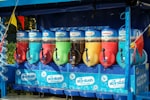In 2016-2017, the NHL levied 13 fines against players. Six were for diving/embellishment; two were for hitting another player in a way that is somehow less okay than usual; one was Ryan Getzlaf abusing an official; one was a trip, and the remaining three were stick infractions.
So far in 2017-2018, there have been eight fines against players, and none of them are for diving. This seems to indicate a real change in policy under George Parros at Player Safety.
The fines this year are: three for the childish water bottle incident between Tampa Bay and the Rangers as well as five other incidents which in the past have been generally left at the penalty assessed with no further discipline given. Those are: two slashings, a crosscheck, a roughing and a high-sticking.
The total fines assessed amounts to $32,815.86 vs the $50,402.77 for all of last year. The 2015-2016 season saw more than double last year’s amount assessed, adding some credence to the idea that Player Safety had gotten a little less effective, but most of the incidents were diving/embellishment or inappropriate gestures. There were 10 on-ice infractions that had fines added after the fact, with slew-footing or stick infractions making up most of them.
Parros has said he’s looking to crack down on intent to injure plays that fall outside regular hockey plays. Seeing two slashing calls that drew fines, as well as the other non-water-related fines, that all seems to add up. Meanwhile, the rate of suspensions is about the same as last year, with the number of games awarded generally lower. The exception to that is the mandated 10-game suspension to Luke Witkowski, and the 10 games given to Radko Gudas for being Radko Gudas in a Radko Gudas-like fashion.
There have been three suspensions for boarding and one for a check to the head, as well as one for interference. This also fits with the idea of an emphasis on punishments for things that can be judged as intent to injure.
The number of incidents that fans are outraged haven’t been punished with suspensions is infinite, as always.
The Rules for Fines
Diving/embellishment has it’s own set of rules, and the fines are given out only after one private warning has been given. They are capped at $5,000.
The CBA rules on other fines are:
18.7 Fines.
(a) The League may issue a fine for conduct that falls short of warranting a suspension.
(b) A fine may be in an amount up to fifty percent (50%) of the Player's Paragraph 1 NHL Salary and Bonuses, but not including Performance Bonuses, divided by the number of days in the Regular Season, but in no event shall it exceed $10,000 for the first fine and $15,000 for any subsequent fine imposed in any rolling twelve (12) month calendar period. Player Salary and Bonuses forfeited due to a fine will be calculated based on a Player's Averaged Amount.
(c) For fines of $5,000 or less the League shall, within seventy-two (72) hours of the completion of the game in which the incident took place, provide: (i) notice of the fine, (ii) an explanation of the fine, and (iii) written reports of on-ice officials and Officiating Managers (if any) to the fined Player, his Club and the NHLPA.
(d) Fines in excess of $5,000 are subject to the telephonic hearing procedures afforded to Players subject to suspension of five (5) games or less, as set forth in Section 18.8.
(e) A recipient of a fine will not be treated as a "repeat" offender for purposes of calculating the amount of compensation that will be forfeited upon suspension pursuant to Section 18.15. However, such a disciplinary fine will carry consequences for the balance of that season and any further Supplementary Discipline for On-Ice Conduct that is imposed in that season will take into account the offense for which the Player has been fined.
To emphasize, these are fines, totally separate from the forfeited salary that comes with suspensions. With the cap on the fine of half on one day’s pay and then ten- to fifteen-thousand dollars, very few players feel much of a bite from this punishment.
The only way they hurt is if they start to pile up or if the player starts suffering tougher suspensions because of this prior record.
The point seems more to be emphasizing that no, really that thing you did was very wrong. When the thing is really, really wrong, Player Safety can issue a suspension.
The Rules for Suspensions
The interesting thing about suspensions, is that there are rules about notice, appeals, timing of the games the player must miss, and a very comprehensive appeal to a neutral arbiter policy. But the only rule about how long a suspension can or should be relates to in-person hearing rights:
18.5 Disciplinary Alternatives.
Following its preliminary review, the League shall have the option to proceed with one of the following disciplinary alternatives:
(a) No discipline of the Player;
(b) A disciplinary fine of the Player, as set forth below in Section 18.7. For all fines in excess of $5,000, the Player shall have the right to a telephonic hearing as set forth in Section 18.7(d). For fines of less than or equal to $5,000, the provisions of subparagraph 18.7(c) shall apply;
(c) A disciplinary suspension of zero (0) to five (5) games, in which case the Player will have the right to a telephonic hearing, as set forth in Section 18.8; or
(d) A disciplinary suspension of six (6) or more games, in which case the Player will have the right to an in-person hearing, as set forth in Section 18.9.
Unlike the fine, which has a cap, suspensions are entirely open-ended and at the discretion of the league. The player forfeits salary along with the games missed, and this should not be confused with a fine, it’s not, it’s a direct docking of pay, and it’s calculated in two ways depending on the “repeat offender” status of the player.
18.15 Forfeiture of Compensation Upon Suspension.
The amount of compensation that will be forfeited by the Player upon suspension shall be calculated on the following basis:
(a) for "first" offenders (first incident requiring Supplementary Discipline for On-Ice Conduct in the form of a game suspension determined pursuant to Section 18.15(d)), Player to forfeit one (1) day's Paragraph 1 NHL Salary and Bonuses, but not including Performance Bonuses, for each Regular Season Game lost (1/total number of days in the season measured from the date of the League's first Regular Season Game to the last, irrespective of the Player's team's schedule);
(b) for "repeat" offenders (second or more incidents requiring game suspension determined pursuant to Section 18.15(d)), Player to forfeit one (1) NHL Game's Paragraph 1 NHL Salary and Bonuses, but not including Performance Bonuses, for each Regular Season Game lost (1/number of Regular Season Games for each Regular Season Game suspended);
(c) Player Salary and Bonuses forfeited due to a suspension will be calculated based on a Player's Averaged Amount, as defined in Article 50 of this Agreement; and
(d) status as a "first" or "repeat" offender shall be re-determined every eighteen (18) months on a rolling basis. For example, where a Player is suspended for the first time, he becomes a repeat offender if he is suspended again within eighteen (18) months of the first incident. If he does not have another suspension within eighteen (18) months of the first incident, his next suspension will be treated as a "first" offense.
The difference is that a first time offender loses a day’s pay. A repeat offender loses a “game’s” pay, or in other words, his salary divided by 82 instead of the usual 185 or so days. The repeat offender’s salary lost is usually more than double that for a first time.
Radko Gudas’ lost salary for his slash on Matthieu Perrault is $408,536.59 because he was a repeat offender. If that seems big, consider that his repeat offender status is chained from a suspension last year that cost him $245,121.96, which carried repeat offender status from 2015-2016 from a three-game suspension for a check to the head. Only long suspensions and the repeat offender status can be seen to have any deterrence effect on players, and the games lost are the big punishment for high-salary players.
Suspensions do not cross leagues. A suspended NHL player can go play in the AHL and vice versa.
The increase in fines is an interesting development in the NHL. They serve essentially as warnings, it seems to me. Until we see evidence that a fined player gets a longer suspension, or that the short duration of suspensions in general goes up, it can also be seen as all sizzle and no steak.



